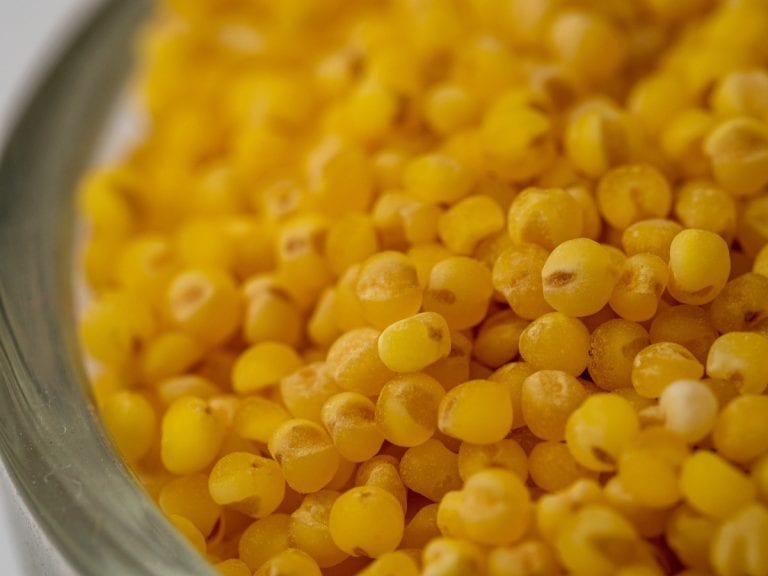Not very widespread in Italy, if not in the gluten-free world, but in ancient times – at the time of Ancient Rome and then also in the Middle Ages – millet had a leading role in our ancestors' nutrition. The grassy plant from which it derives is native to Asia – where it is still very widespread, as in Africa and India, also due to its resistance and the ability to grow even in extreme conditions, exposed to high temperatures and in drought and desert environments. It does not need much attention, therefore, to the point of being – in some areas – considered a weed. Of the different varieties of millet, the most commonly used is Panicum miliaceum for human and animal consumption, mainly as bird feed, as it responds optimally to the nutritional needs of these animals.
Millet flour. Features and tips for choosing
Golden or brown, depending on whether the grain is peeled or not: millet flour, in the two types available on the market, differs not only in colour but also in other characteristics. Delicate aroma, with vague vegetable aromas and a slightly sweet taste – the first, which although lighter than the other, still has a yellowish hue that other gluten-free flours don't have – while the second, more difficult to find, has slightly more intense characteristics due to the presence of glumellae surrounding the caryopsis. From a nutritional point of view, the whole-grain version (dark or wild) is very rich in minerals. The two types can be used alone or mixed together, or even mixed with other flours, for making dough. It is used cooked or raw to enrich fruit salads or other fresh preparations.
Millet flour: lots of energy, zero gluten
Good news for athletes: millet flour is a protein goldmine (between 10 and 12 g per 100 g: slightly less than oats, more than common soft wheat flours and above all it's gluten-free). Plus it contains on average more than double the lipids compared to other grains (without touching, however, the values of almonds, coconuts or pistachios), also high carbohydrate content (about 70%) that provide the organism ready-for-use energy. Especially in the whole-grain version, millet retains many vitamins (especially of A and B groups), with regard to minerals, however, the most consistent presence is of potassium, mineral content also changes according to the soil in which they are grown. The presence of fiber is also high even in the case of golden millet (although lower than those contained in chickpea, chestnut and lupin flour) which reduce absorption and facilitate intestinal transit. On the other hand, we are still talking about a product with a caloric density comparable to flour for bread making (370 Kcal per 100 g). However, the presence of gluten should not be underestimated: despite being almost devoid of it, oat flour could cause some problems for coeliac subjects.
Millet. The plant, the grain and the flour
The seeds are small yellowish grains that grow inside a corn-like ear, they are collected before the plant dies, and then dried. Although millet has good shelf life, the same cannot be said for millet flour that is easily perishable, which is why it's preferable to grind it a little at a time to avoid oxidation compromising the flavour (sifted or not, according to whether you want to obtain a more or less fine result). Brown millet gives a more rustic and intense flavour, just as the flavour of the flour obtained from the toasted grain is bolder.
The absence of gluten does not make it particularly suitable for leavened products, so it's generally used for cookies, flatbreads, scones or crêpes, especially for macrobiotic or gluten-free diets.
Angela Fiorini's recipes with millet flour
We have already told you the story of Angela Fiorini, who with her daughters Valentina and Eleonora opened a store in Zagarolo, near Rome. A small shop of fresh pasta where everything is made with love and great care, and there is no lack of continuous experiments in the fillings (just think of the famous raviolio; or the stuffed pasta with typical dishes of the town such as "tordo matto'' or the sausage and grapes combo). Experiments are also done on pasta, while fully respecting the artisan tradition. In the laboratory stone-ground flours are used, often from native grains, but over time the selection has become wider, also expanding to alternative flours, also excellent for those with particular nutritional needs. From this continuous experimentation they consolidated their proposal and won the hearts of many, enthusiasts and professionals alike. They accepted the challenge of making pasta with millet flour. How does it behave compared to classic flours?
Meraviglie in Pasta - Zagarolo (RM) - corso Vittorio Emanuele, 101 - www.meraviglieinpasta.it
Millet flour fettuccine recipe
Ingredients for 4
400 g milleto flour
6 egg whites
Place the flour in a mound on the work surface, creating a volcano then pour the egg whites in the centre. Start bringing in the flour using a fork, making it absorb into the egg whites, when the shaggy dough begins to come together, start kneading with your hands, using the heels of your palms and not your fingers. We only use egg whites because it gives the pasta greater elasticity and once the dough is created it will be much easier to roll it out and shape the fettuccine.
It is a very delicate flour, cooking must be very short: just one minute, one and a half minutes tops, in plenty of boiling salted water. Either way it will be ready when it floats to the surface.
The taste of the pasta is delicious, delicate, without particular flavours so it is suitable for any sauce. In this season it can be made with courgette flowers and anchovies, or a few fresh cherry tomatoes and basil.
by Antonella De Santis


 Women are the best sommeliers. Here are the scientific studies
Women are the best sommeliers. Here are the scientific studies Where to eat at a farm stay in Sicily: the best addresses in the Provinces of Trapani, Palermo, and Agrigento
Where to eat at a farm stay in Sicily: the best addresses in the Provinces of Trapani, Palermo, and Agrigento Wine in cans, bottle-fermented, and alcohol free: the unstoppable change in Gen Z’s tastes
Wine in cans, bottle-fermented, and alcohol free: the unstoppable change in Gen Z’s tastes The great Bordeaux exodus of Chinese entrepreneurs: around fifty Châteaux up for sale
The great Bordeaux exodus of Chinese entrepreneurs: around fifty Châteaux up for sale Dubai speaks Italian: a journey through the Emirate's best Italian restaurants
Dubai speaks Italian: a journey through the Emirate's best Italian restaurants






